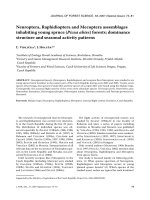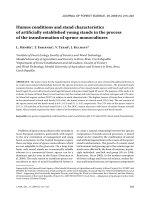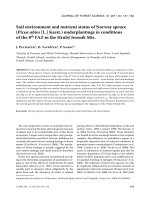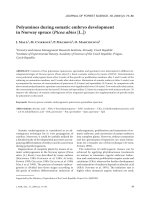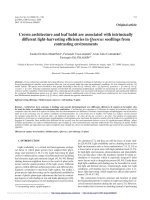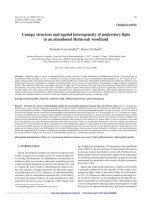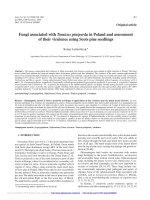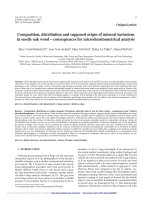Báo cáo lâm nghiệp: "Water movement and its resistance in young trees of Cryptomeria japonica" pot
Bạn đang xem bản rút gọn của tài liệu. Xem và tải ngay bản đầy đủ của tài liệu tại đây (228.53 KB, 5 trang )
Water
movement
and
its
resistance
in
young
trees
of
Cryptomeria
japonica
H.
Yahata
Laboratory
of
Silviculture,
Department
of
Forestry,
Faculty
of
Agriculture,
Kyushu
University,
Fukuoka,
Japan
Introduction
Information
about
water
flow
resistance
is
essential
to
understanding
and
simulating
water
movement
in
trees
(Yahata,
1987).
There
are
a
number
of
papers
concerned
with
it
for
some
species
but
few
for
Cryp-
tomeria japonica
and
no
data
are
available
on
the
gradient
of
water
potential
in
intact
stem.
This
study
was
undertaken
to
examine
whether
the
resistance
in
stems
would be
regarded
as
substantially
constant
all
day
long
and
to
find
a
simple
equation
to
predict
the
effect
of
stem
form
on
it.
Materials
and
Methods
14
yr
old
C.
japonica
trees
growing
in
a
planta-
tion
of
high
stand
density
about
6650
stems
per
ha
were
used.
Psychrometer
sensors
(Wescor
PCT55-30)
were
used
with
an
automated
recording
system
for
measuring
the
water
potential
of
soil
at
a
depth
of
20
cm
and
root-
stock
at
10
cm,
and
a
Scholander
pressure
chamber
for
shoots.
The
sensors
were
placed
and
sealed
in
small
drilled
holes
in
the
stem
and
rootstock.
Diurnal
variation
of
the
ambient
temperature
of
the
sensors
was
minimized
to
within
less
than
1°C
by
the
use
of
insulating
materials
to
reduce
errors
from
temperature
gradients.
Transpiration
rates
were
estimated
by
the
measurement
of
leaf
conductance
to
water
vapor
and
the
ambient
vapor
deficit
be-
tween
leaf
and
air.
The
water
flow
rates
in
the
stem
at
different
heights
(0.5-2.5
m)
were
esti-
mated
using
the
relationships
between
the
heat-pulse
velocity,
measured
with
an
automa-
tic
multichannel
recording
system
(Yahata,
1984)
and
the
water
uptake
rates
from
the
severed
basal
stem
at
the
end
of
a
series
of
measurements
of
the
intact
tree.
Sapwood
conducting
area
was
measured
by
using
a
dye
(1%
solution of
acid
fuchsine).
Water
flow
rate,
Q,
is
customarily
expressed
as
an
Ohm’s
law
analogy
with
resistance,
R,
and
the
water
potential
gradient,
Δψ,
in
the
fol-
lowing
equation
(eqn.
1).
Q
=
(Δψ-ρgh)/R,
where
pgh
is
the
gravitational
potential
at
a
height
of
h
(m).
By
using
the
above
equation
with
the
water
flow
rate
in
the
stem
in
place
of
Q
and
the
gradients
of
water
potential
between
soil
and
leaves,
.1"
’
s-
1
>
or
between
rootstock
and
leaves,
dyr
r-,,
the
resistance
of
total
path-
way,
Rsfac!
and
between
root
and
leaves,
R,,
and
between
soil
and
root,
R
S+n
were
de-
termined,
respectively.
Provided
that
the
relative
resistance
r,
(m-
2
),
as
defined
by
Jarvis
(1975),
is
constant
throughout
a
stem
with
a
length
of
(m),
total
resistance
R,!a,
(Pa
’
s.m-
3)
can
be
written
as
follows
(eqn.
2):
f?!
=
11=
(r,nlA)
d/
=
rr
17
/,,
where
la
= j
J (1M)
dl,
which
can
be
considered
to
be
an
index
of
resistance
based
on
stem
form,
and
A
is
the
cross-sectional
area
of
sap-
wood,
and
ri
is
the
viscosity
of
water
(N
’s’
m-
2
).
Results
On
the
clear
day
of
August
20th,
when
the
soil
was
dry,
the
predawn
water
potential
of
leaves
was
0.2!.3
MPa
lower
than
the
soil.
On
the
other
hand,
the
water
potential
of
rootstock
was
higher
by
about
0.1
MPa
than
the
soil
and
began
to
decrease
after
sunrise
slowing
after
the
leaves
and
be-
came
lower
than
the
soil
about
9:00.
It
was
confirmed
here,
too,
that
water
move-
ment
occurred
along
the
water
potential
gradient
of
soil,
rootstock
and
leaves
during
daytime,
but
reverse
gradients
of
water
potential
of
about
0.1
MPa
were
observed
at
night
and
in
the
early
morning
when
the
water
flow
declined.
Fig.
1
shows
the
relationships
between
the
water
potential
gradient
and
the
water
movement
in
the
tree.
Linear
regression
curves
intersecting
at
pgh
=
0.0608
MPa
on
the
axis
of
ordinates
fitted
the
observa-
tions
better.
The
computed
resistance
of
total
pathway,
Rspa
,,
of
stem,
RX,
and
of
the
pathway
from
soil
to
rootstock,
R
S+n
r,
were
8987,
7218
and
1769
MPa-s-kg-
1
(=
x10
3
MPa-s-m-
3
),
respectively,
by
using
the
water
flow
in
place
of
Q.
When
transpi-
ration
was
used
instead
of
the
water
flow,
the
resistances
were
slightly
lower
but
there
were
no
substantial
differences
in
the
resistance.
While
the
resistance
mea-
sured
in
the
forenoon
was
larger
than
that
in
the
afternoon,
especially,
for
RX,
when
estimated
with
the
water
flow,
they
were
reversed
when
estimated
with
transpira-
tion.
This
seems
a
quite
predictable
result
when
taking
account
of
the
time
lag
be-
tween
water
flow
in
the
canopy
and
in
the
stem.
Furthermore,
using
the
data
of
water
flow
in
the
stem,
there
was
a
larger
diurnal
variation
of
RX
than
of
R
sPac
.
This
variation
is
considered
to
result
from
the
fact
that
the
relative
distance
of
the
measuring
point
for
water
flow
was
very
close
to
the
measuring
point
for
water
potential
of
root-
stock.
In
order
to
keep
a
steady
state,
it
is
considered
that
the
measuring
point
for
water
flow
should
be
located
in
the
middle
of
the
range
of
the
points
for
water
potential.
Therefore,
in
the
following
expe-
riment,
the
water
potential
gradients
in
the
stem
between
0
and
3
m
aboveground
and
water
flow
rates
between
the
2
points
were
measured.
As
a
result,
no
essential
diurnal
changes
of
resistance
were
ob-
served,
and
the
R,
3,
the
resistance
be-
tween
0
and
3
m,
was
2006
MPa-s-kg-
1.
The
changes
in
la
calculated
with
the
cross-sectional
areas
of
sapwood
indicate
that
la
is
very
small
in
the
lower
part
of
the
stem
and
increases
with
height
of
the
stem.
The
value
of
r,,
estimated
by
eqn.
2
using
the
value
of
la
up
to
3.0
m
and
R,,3,
was
2.11
x 10
1-!
m-2.
As
an
example
of
the
calculation
of
eqn.
2,
an
effect
of
reducing
the
water
flow
pathway
on
the
index
of
resistance,
la,
was
examined,
providing
that
the
cross-
sectional
area
of
sapwood
at
1
m
high
was
reduced
to
5
cm
2
and
the
permeability
was
lost
with
a
thickness
of
10
cm.
It
is
clear
that
the
influence
was
small
com-
pared
to
the
resistance
of
water
flow.
In
Fig.
2,
using
the
above
equation,
resistance
between
stem
base
and
0.5
m
below
the
top
of
trees
and
the
water
flow
rates
to
the
top
shoot
when
the
water
potential
gradient
was
1
MPa,
were
calcu-
lated.
In
this
calculation,
the
equation
of
relative
stem
form
and
the
yield
table
published
for
C.
japonica
were
used.
At
the
beginning
of
the
growth
stage,
the
calculated
resistance
R
xcal
increased
with
height
growth
up
to
about
5
m,
and
sub-
sequently
the
increasing
rate
declined.
The
width
of
sapwood,
which
was
con-
sidered
to
be
almost
constant
vertically
throughout
the
stem,
did
not
affect
the
resistance
and
the
water
flow,
but
the
stem
forms
did
significantly
affect
the
resistance
and
the
water
flow.
Discussion
and
Conclusion
It
was
confirmed
that
there
is
a
gradient
of
water
potential
along
the
pathway
of
water
flow,
but
there
was
a
reverse
gradient
be-
tween
soil
and
rootstock
when
the
water
flow
declined.
This
result
might
suggest
the
possibility
of
real
active
water
uptake
by
roots.
However,
further
study
is
neces-
sary to
include
the
possibility.
Diurnal
changes
in
the
resistance
to
water
flow
have
been
reported,
the
resis-
tance
tending
to
rise
in
the
afternoon
(Nnyamah
et al.,
1978).
Nevertheless,
the
measuring
point
of
water
flow
in
relation
to
those
of
water
potential
could
possibly
cause
the
diurnal
change.
It
is
probable
that
the
resistance
to
water
flow
in
the
stem
is
substantially
constant
for
C.
japo-
nica.
Although
eqn.
2
for
predicting
the
effect
of
stem
form
and
growth
on
the
water
stress
to
the
top
shoot
should
be
tested
in
practice,
it
could
provide
a
simple
model
of
the
effect
on
the
water
movement
in
stems.
References
Jarvis
P.
(1&75)
Water
transfer
in
plants.
In: Heat
and
Mass
Transfer
in
the
Plant
Environ-
ment.
Part
1.
(de
Vries
DA
&
Afgan
N.G.,
eds).
Scn
p
ta
Book
Co.,
Washington,
D,C.,
pp.
369
’
394
Nnyamah
J.U.,
Black
!;A.
&
Tan
C.
(1978)
Resistance
to
water
uptake
in
a
Douglas
fir
forest.
Soil Sel. 1
27
, 63-76
Yahata
H.
(1984}
An
automatic
multichannel
recording
system
for
a
heat-pulse
velocity
tech-
nique.
J.
Jpn.
For
Sac.
66
.
241-246
Yahata
H.
(1987)
Water
relations
charaotoris-
tics
of
Cryptomeria
japonica
D.
Don
(Vi).
A
simulation
model
of
water
regime
using
the
parameters
obtained
by
the
P-V
curve
technique.
J Fac.
ttgrio:
Kyushu
itruV.
31,
235-
245
